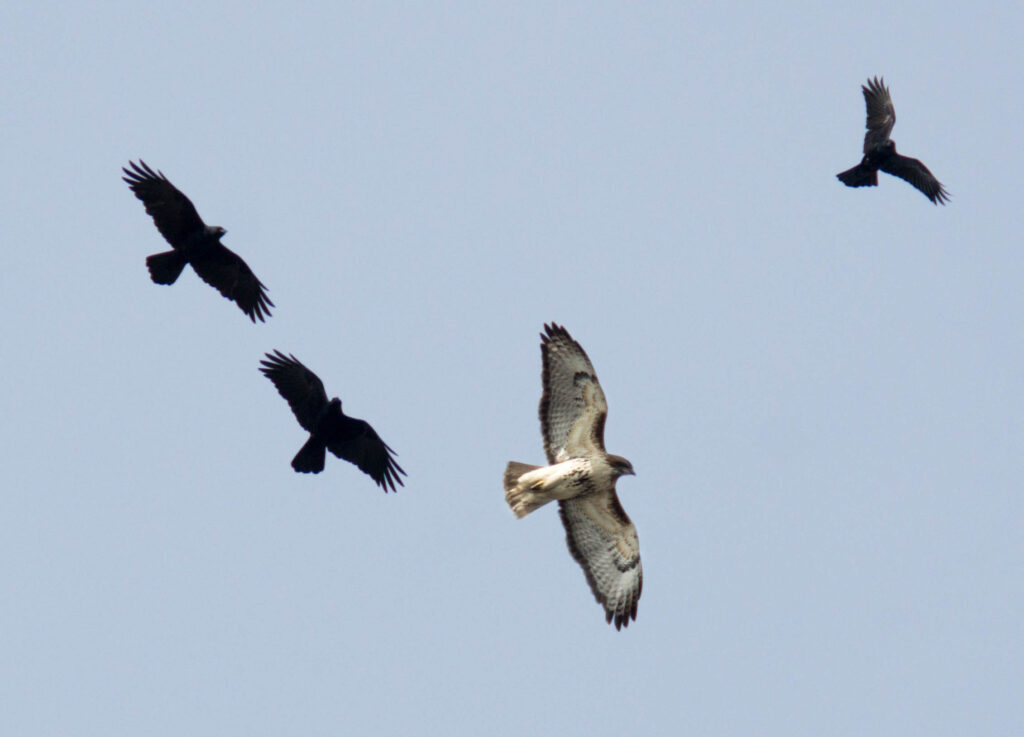Almanac: Mobsters

A hawk being mobbed by three crows. Photo: Will Pollard (Creative Commons)
I was descending the steep trail down North Sugarloaf mountain in Deerfield last weekend when I heard a caterwauling coming from somewhere in the canopy. I couldn’t see anything, but I was fairly sure I was hearing a couple of annoyed or upset ravens. Ravens have an impressively large repertoire of calls and “songs.” None are particularly melodious—weird is more like it—with the most common sound being a deep “gargling with rocks” kind of croaking.
These ravens were not gargling. The calls were loud and harsh, almost like a human scream, with an urgency that I hadn’t heard before. I stood still, listening. Then from the corner of my eye I caught sight of a raven flying downslope through the forest, with a blue jay in hot pursuit. The raven yelled at the jay and the jay yelled at the raven as they flew between the trees. I lost the pair visually, although I could hear the mutual scolding continue for another 20 seconds.
This was the second time in a week that I’d seen a jay/raven confrontation. Several days earlier I heard some jays making a ruckus in my back yard. Walking to investigate I saw a raven flying away, followed by four or five jays, which were taking turns dive-bombing the larger bird. This group behavior, as well as the solo-pestering I saw on the mountain, is called “mobbing.”
Small birds often mob larger birds in defense of territory, a food source, or to protect young. In many cases, the bird being mobbed is a predator, such as a hawk, eagle, or owl, although any large bird can be a target, even if, as with herons, the birds don’t pose any danger to a nest or young.
The exact behaviors involved in mobbing vary widely, but they often involve loud, aggressive calls, dive-bombing, and even physical contact. The goal isn’t to harm so much as to pester the predator enough to leave the area. This strategy often works. The larger birds are usually less agile than the smaller ones, so it would be a lot of work to chase or capture a tormentor. It’s easier to just leave rather than mount a counter-attack.
Mobbing behavior might serve other functions for the smaller birds as well. It can serve as a signal to other birds in the area, alerting them to the presence of a predator. It may also demonstrate the fitness of the mobbing bird to potential mates, since the ability to successfully harass a predator is a great sign of avian courage and strength.
It’s also possible for a bird to play both roles: the mobber and mobbed. Ravens, for example, will readily mob owls, hawks, or eagles that threaten their nests. But ravens are also opportunistic feeders and aren’t above snacking on other birds chicks or eggs, so, as I witnessed, they can be targeted by jays and other small birds.
Mobbing behavior is fairly common across many bird species, especially among perching birds and songbirds. Mockingbirds, for example, are known for their strong defensive behaviors and are known to mob and attack predators, including humans if they get too close to their nests. Robins and other thrushes can sometimes be seen mobbing cats or larger birds. Swallows, chickadees, and starlings are also known to organize mobs against potential threats.
Mobbing can happen any time of year, but it is especially common in spring and early summer as birds experience surges of hormones, become territorial, and begin to nest. Keep your eyes out for these behaviors and post a comment below to share any observations!
Almanac is a regular Indy column of observations, musings, and occasional harangues related to the woods, waters, mountains, and skies of the Pioneer Valley. Please feel free to comment on posts and add your own experiences or observations.
